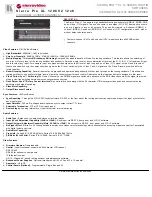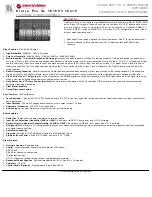
System will disconnect the selected headset or panel microphone from the intercom
line(s). This allows the MS-232 microphone to be used to cue talent without affecting in-
tercom line communication.
7
LONG LINE A: If a long cable run on Channel A is unavoidable and approaches 1,000
feet or more, set the Long Line A option switch to the ON position. The ability to set a
sidetone null on Channel A depends upon properly setting this switch.
8
LONG LINE B: If a long cable run on Channel B is unavoidable and approaches 1,000
feet or more, set the Long Line B option switch to the ON position. The ability to set a
sidetone null on Channel B depends upon properly setting this switch.
16
Termination Switches: These switches provide switchable terminations for channels A and
B. In most systems, both terminations on the MS-232 should be in the ON position (default
setting). The fundamental concept of Clear-Com Party-Line intercom is that all channels are
terminated in one location, preferably at a main station or power supply. The termination
switches on the MS-232 rear panel should be set to the OFF position only if the channel is ter-
minated by another main station or power supply in the system. If there are no other main
stations, power supplies, or other terminations on the line, set the rear panel switches
labeled TERM A and TERM B to the ON position.
NOTE: All intercom lines must be terminated only once, whether they are used or not.
Never "double-terminate" a line.
17
Power Switch: The power switch can be used to turn AC power to the MS-232 on and off.
When in the ON position, the Power LED on the front panel will be illuminated.
20
AC Power Connection: An IEC type 320 connector is provided to interface to the appropri-
ate AC power cord to be used. Voltages from 90 to 240 VAC at 50 or 60 Hz are acceptable.
The MS-232 will automatically adjust for the power applied, so there are no manual switches
to set power line voltage or frequency.
21
Intercom Line Connection: The MS-232 contains three 3-pin male XLR connectors for each
intercom line. These connectors are wired in parallel. Any single-channel station or channel
of a multi-channel station connected on a line plugged into Channel A of the MS-232 will be
"party-lined" with all the other stations on that channel. In a multi-channel system, the goal is
to assign specific people to the correct group, i.e. the other people they need to be in contact
with the most. This is particularly important when the party line users are on a single-channel
beltpack or station; less so if they are on multi-channel stations. The pinout of the intercom
connectors is as follows:
Pin 1 --- Ground (Shield)
Pin 2 --- Power (+30 VDC)
Pin 3 --- Audio
22
Program Input: A 3-pin XLR female connector provides the main program input to the sta-
tion. Program can be fed to the headphone or speaker as well as to either or both of the inter-
com channels. The level to the speaker or headphone is controlled by the Program Level
control. The Program ON-OFF-INTRPT switches control whether each intercom channel re-
ceives program audio. The program audio levels on each intercom channel can be adjusted
using the individual Program Level trimpots. The Program Input accepts a balanced or unbal-
anced line-level audio signal from -20 dBv to +10 dBv. An option is to feed program audio to
the Announce Output. This is selected by setting jumper JP2 on the Main board to the ON po-
sition. When this option is selected, a 0 dBv signal on the Program Input will produce a 0dBv
signal on the Announce Output.
The pinout of the Program Input connector is as follows:
Pin 1 --- Ground (Shield)
Pin 2 --- + Signal
Pin 3 --- - Signal
Clear-Com MS-232 Two-Channel Main Station
7
Содержание MS-232
Страница 13: ......







































